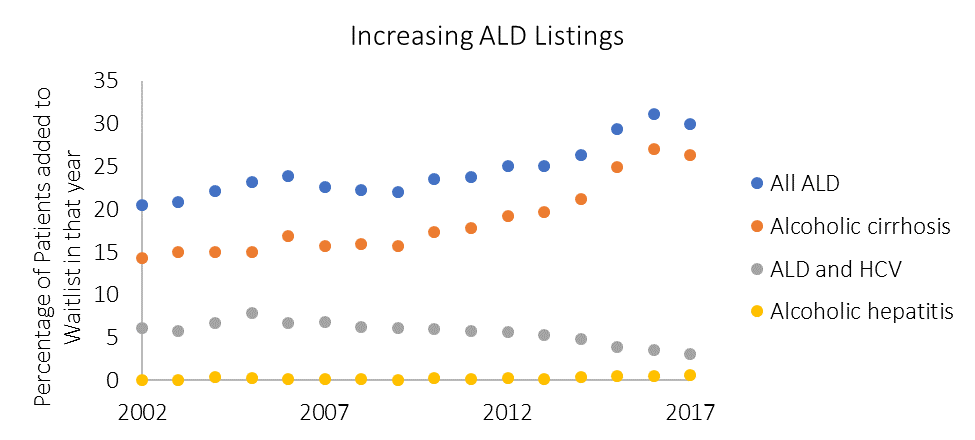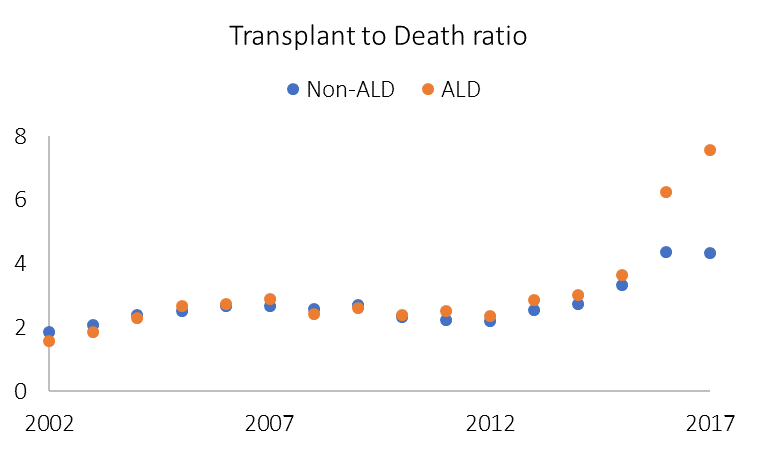Increasing Incidence and Transplantation of Individuals Listed with Alcoholic Liver Disease
1Department of Student Affairs, Baylor College of Medicine, Houston, TX, 2Division of Abdominal Transplantation, Baylor College of Medicine, Houston, TX
Meeting: 2019 American Transplant Congress
Abstract number: C294
Keywords: Alcohol, Liver cirrhosis, Liver transplantation, Waiting lists
Session Information
Session Name: Poster Session C: Liver: MELD, Allocation and Donor Issues (DCD/ECD)
Session Type: Poster Session
Date: Monday, June 3, 2019
Session Time: 6:00pm-7:00pm
 Presentation Time: 6:00pm-7:00pm
Presentation Time: 6:00pm-7:00pm
Location: Hall C & D
*Purpose: Alcoholic liver disease (ALD) has recently become the most common indication for liver transplantation in the US; it is important to characterize changes in the population with ALD.
*Methods: The United Network for Organ Sharing STAR files were examined across the modern era (March 2002 to December 2017), including 135,956 patients.
*Results: As has been previously observed, ALD has grown to surpass all other indications for listing for transplantation. Alcoholic cirrhosis alone has increased most; alcoholic hepatitis has almost doubled as an indication for listing since 2004 but still accounts for only 0.64% of individuals listed in 2017. While the population listed for ALD is overwhelmingly male, the proportion of females is increasing over time. This increase in ALD is observed across all 11 OPTN regions but has been reported at twice the rate in Region 2, increasing by 1.3% annually compared to the average half point reported in other regions. Further analysis is needed to assess whether this represents a true population difference in Region 2, or a change in reporting.
The most significant declining diagnosis is hepatitis C (HCV) cirrhosis. Hepatitis C positive serostatus (regardless of underlying disease) has also decreased in transplant recipients from 50% positive in 2002 to 10% positive in 2017. This is to be expected given increasingly effective antiviral therapies. In terms of parity between those listed with alcoholic liver diseases and those listed for non-alcoholic indications, the percentage of individuals receiving transplants has been increasing similarly across groups until 2014. Since 2015, the percentage of individuals transplanted for alcoholic liver disease increased (from 41% in 2014 to 45 and 49% in 2015 and 2016) more than for other etiologies (from 39%, to 40 and 41%). Examined as a ratio of patients transplanted to waitlist deaths, transplant to death percentage in ALD has been improving in parallel with the non-ALD population, rising from under 2 (1.8 and 1.6) in 2002 to over 3 (3.6 and 3.3) in 2015. Transplant to death ratio increased to 7.6 in 2017 the ALD group but only to 4.3 in the non-ALD group, again indicating increased transplantation. This may be related to presentation of ALD at later stages of disease, with higher lab MELD scores at listing (23.6 for ALD vs 20.22 for non-ALD in 2016, p<0.0001).
*Conclusions: Alcoholic liver disease is increasing, presents at a later disease stage, and accounts for a greater relative proportion of transplants than other indications. Continued evaluation of the relative severity at which patients are listed and their waitlist course is needed to determine if and when the elevated transplantation rate in ALD relative to other patients is appropriate.
To cite this abstract in AMA style:
Godfrey EL, Rana A, Goss JA. Increasing Incidence and Transplantation of Individuals Listed with Alcoholic Liver Disease [abstract]. Am J Transplant. 2019; 19 (suppl 3). https://atcmeetingabstracts.com/abstract/increasing-incidence-and-transplantation-of-individuals-listed-with-alcoholic-liver-disease/. Accessed December 22, 2025.« Back to 2019 American Transplant Congress


